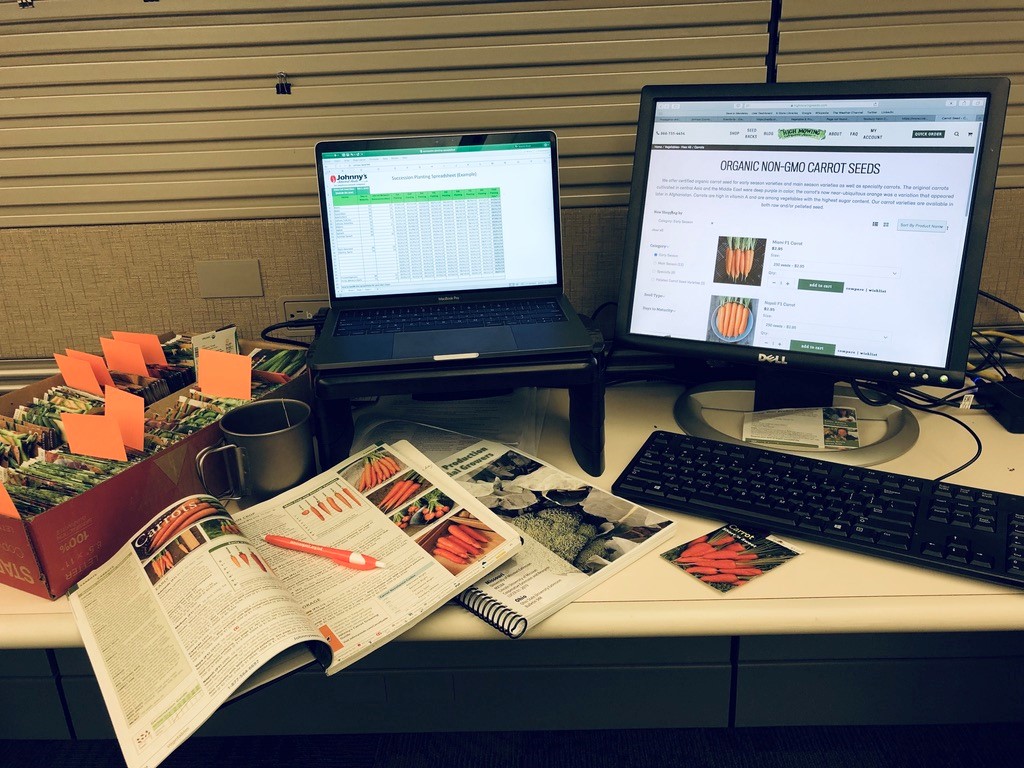Making Sense of Seed Catalogs

Following a warmer than usual fall, which allowed for a longer growing season, it may feel like we’re only just now getting a break from being outdoors. And for most of us avid gardeners (i.e. garden-supply “super shoppers”) the stacks of seed catalogues have probably been piling up over the last month. While it’s fun to peruse the artfully designed pages and gaze longingly at the beautiful photos of new varieties, it’s also overwhelming to make sense of it all.
Seeds should be obtained early in the year so you can get the varieties you want. This is especially true for other types of planting material, i.e. fruit trees, seed potatoes and onion transplants. In general, the average home grower will get all the seeds they need in one packet.
In addition to catalogues, which are reliably shipped to most previous year’s buyers (big and small), gardeners can also find seeds labeled for the current year at local nurseries and online seed catalogues/companies. For those that find themselves with left over seed from years past, a good rule of thumb is that most seed will stay viable for at least a year at room temperature and 3-10 years when stored in the refrigerator using a dry sealed container. Otherwise, buy new seed. Save yourself the disappointment of waiting forever on bean that will never sprout.

For the average home vegetable gardener, we always recommend growing things you have space for and crops you like to eat at home. There’s no sense in buying seeds for a sprawling watermelon plant or sweetcorn if your growing space amounts to a container that sits on your balcony.

Aside from your personal culinary preferences and/or space requirements there are few other key factors that can help you make your purchasing decisions. The first notation you might see next to any given variety in the catalogue is the breeding classification, hybrid (e.g. F1), open pollinated and/or heirloom. These are all great options, but here are the main differences:
Hybrid just means the variety is a cross between at least 2 parents, this is done using age old breeding technique and is not the same as GMO (genetically modified organisms)—which are rarely available to the average home grower. Hybrids are generally known for their consistency, disease tolerance and yield. But hybrids are not best for seed savers, because they can produce atypical plants in following generations.
Heirloom’s and open-pollinated (OP) are very similar, generally all heirlooms are OP but not all OPs are heirlooms. An heirloom is usually defined as a cultivar with 50 years or more in cultivation and seed saving. Both represent varieties that are genetically stable through years of natural selection. Even when they self-pollinate or cross-pollinate with other plants they produce seed that are true-to-type year after year—so better for seed savers. Although not always the case, heirlooms are often selected because of their reputation for flavor, unique colors, shapes, tender skin and more quality characteristics.
Beyond breeding background there is also organic vs conventional seed. This is a distinction that lets you know whether the seed was produced using synthetic pesticides or fertilizers but it doesn’t affect what methods the end user will implement in their own garden. If you are especially resistant to synthetic chemicals in your garden, be aware that some conventional seed is treated and avoid these types.
A few of the other important distinctions include:
Heat/Cold Tolerance – If you’re growing cool-season veg like lettuce late into the spring or summer find heat tolerant varieties that won’t bolt. And if you need winter greens that can be planted later in the season, look for cold tolerance or cold hardy. Some varieties may also germinate in colder or warmer soils which can help you schedule plantings earlier or later depending.
Days to Maturity (DTM) – Allows you to time planting and harvest properly, know when to plant to get your crop or to avoid frost or high temps before harvest. Read the catalog, seed packet, or label, you can sometimes get DTM from day of seeding or transplanting.

Disease Resistance – This is especially important for small gardens, where it’s difficult to do true crop rotation and diseases/pests can accumulate in soil or nearby plant residues. There are widely available varieties with disease resistance for soil-borne diseases and nematodes (V, F, and N) powdery mildew resistance and tolerance of squash vine borer just to name a few. If you had disease issues in the past look for these varieties, there is almost always a key provided to parse out all the abbreviations—it’s worth the effort!
And of course there are many other characteristics that you could look for in each variety descriptions, e.g. flavor, color, texture, size/shape, yield, ease to grow. But don’t just be swooned by the best picture in the catalogue, use our Recommended Variety List for the tried and true types with proven success in our region. Research based info is always best, like variety details provided by university/extension sources.
Try a range of varieties. Plant more than one plant! –some tested and some new, you’ll progressively learn more about the differences in productivity, responses to weather conditions and tolerances of other important factors. Enjoy the restful time that winter can provide and the great reading material too!
Have questions? The Garden Hotline is staffed by trained EMG volunteers and Extension staff who will assist you with questions.
Hoppenstedt, 2021
Phone: (913) 715-7050
Email: garden.help@jocogov.org